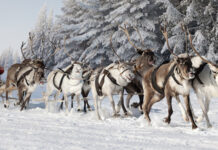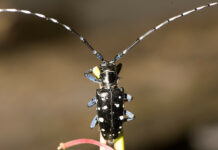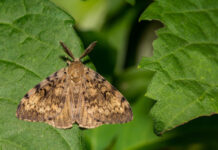
Today’s the first day of Spring and along with greening turfgrass, singing birds, and blooming daffodils, are the far less welcome signs of warming temperatures—the return of hungry invasive insects. In South Carolina, for instance, they are starting to see frass, a sawdust-like material, that Asian long-horned beetles (ALB) within trees will start to push out as the weather gets warmer. Then there are the spotted lanternfly (SLF) and spongy moth egg masses just waiting to hatch!
What can you do? Here are some recent updates on a few key invasive insects from the USDA’s Animal and Plant Health Inspection Service (APHIS).
Spotted Lanternfly & Spongy Moth

First, APHIS wants your help looking for SLF and spongy moth egg masses on vehicles, trees, and other outdoor surfaces during the early Spring. If you find them, APHIS recommends smashing and scraping the invasive egg masses off into plastic bags, sealing them, and disposing of them in the municipal trash. Pressure washing is also an effective way of removing egg masses from hard, outdoor surfaces.
Both of these invasive insects defoliate hundreds of tree and plant species. Each are able hitchhike in their egg mass life stage by attaching to and traveling unnoticed on trucks, cars, trains, planes, and items people leave outdoors and then move to other locales. The SLF is currently found in 17 states; the spongy moth has been detected in 20. It’s important to keep these pests from hitchhiking to new states.
Here are a few tips:
- Smash and scrape spongy moth and SLF egg masses during late Fall, Winter, and early Spring, when these pests are dormant in their egg mass life stage. SLF egg masses are flat and mud-like; spongy moth egg masses are fuzzy, spongy, and cream or brown-colored. These invasive pest egg masses can travel long distances on the items people travel with and can start infestations in new parts of the country.
- If you live in a quarantine area for either pest, your state department of agriculture will have guidance posted specific to your area.
- If you are passing through or leaving a SLF or spongy moth quarantine area, check your vehicle, and your belongings for all life stages of these pests.
- Don’t move untreated firewood to new places. It can easily introduce invasive pests that kill or defoliate forests. Source firewood where you will burn it or buy certified, heat-treated firewood before you travel.
- If you live in an area where these pests are not established and see a SLF, spongy moth, or any of their life stages, please report the sighting to your state’s department of agriculture.
Asian Long-Horned Beetle

APHIS also works together with State, Federal, and other partners to eradicate ALB. This includes imposing quarantines, conducting tree inspections, removing infested trees (and sometimes high-risk host trees), and using a systemic insecticide when appropriate.
ALB is in four states: Massachusetts, New York, Ohio, and South Carolina. Eradication efforts eliminated infestations in Illinois and New Jersey. If you live in a quarantine area, please keep this tree-killing pest from spreading. Follow state and federal laws. These laws restrict the movement of woody material and untreated firewood.
ALB eradication employees are starting to see frass, a sawdust-like material, in South Carolina. ALB inside infested trees will start to push frass out of the tree as the weather gets warmer.
SOUTH CAROLINA – First detection: May 2020
Regulated Area: 76.4 sq. miles in Charleston/Dorchester Counties
For more information, call 843-973-8329 or click South Carolina.
OHIO – First detection: June 2011
Regulated Area: 49 sq. miles in Clermont County
For more information, call 513-381-7180 or click Ohio.
MASSACHUSETTS – First detection: August 2008
Regulated Area: 110 sq. miles in Worcester County
For more information, call 508-852-8090 or click Massachusetts.
Massachusetts Job Opportunities: The Massachusetts Department of Conservation and Recreation is hiring eight long-term seasonal positions working on the ALB eradication program. They are hiring six Seasonal Forestry Assistants for ground tree inspection surveys. And two Seasonal Forestry Assistants for ALB trapping work. Read the ALB Ground Survey Job Description and the ALB Trapping Job Description to learn more.
NEW YORK – First detection: August 1996
Regulated Area: 42.9 sq. miles in Nassau/Suffolk County
For more information, call 866-265-0301 or click New York.
If you think you’ve found ALB or an infested tree, record the area, capture the insect, and take digital pictures. Then contact the eradication program operating in your state. Or you can call the ALB hotline at 866-702-9938 or report online.
Emerald Ash Borer
A horrible invasive insect, emerald ash borer (EAB) is in 36 states and the District of Columbia. They include: Alabama, Arkansas, Colorado, Connecticut, Delaware, Georgia, Illinois, Indiana, Iowa, Kansas, Kentucky, Louisiana, Maine, Maryland, Massachusetts, Michigan, Minnesota, Missouri, Nebraska, New Hampshire, New Jersey, New York, North Carolina, Ohio, Oklahoma, Oregon, Pennsylvania, Rhode Island, South Carolina, South Dakota, Tennessee, Texas, Vermont, Virginia, West Virginia, and Wisconsin.

The USDA is using EAB’s natural enemies as biocontrol agents. Tiny stingless wasps, Tetrastichus planipennisi, are showing promise in terms of protecting young ash saplings in a number of states. Research finds that parasitic infections from the wasp cause EAB larvae to eat less. And their energy slows down. The more parasitoid offspring in EAB larva, the less and less the larva eat. This reduces feeding damage caused by EAB larvae to infested ash trees. To learn more, see Questions and Answers: Biological Control for Emerald Ash Borer. If you have questions, call 1-866-322-4512 or email eab.biocontrol.program@usda.gov.
For more on invasive insects, see:
USDA Invests $70 Million To Defend Against Plant Pests & Diseases
The Spongy Moth…It’s Back And Spreading. Find Out Where.
Top 20 Regions For Spotted Lanternfly











![[VIDEO] Dickies®: Discover Workwear That’s Anything But Uniform](https://turfmagazine.com/wp-content/uploads/2023/06/1647663814-4b1a2a7742790a9b1e97a3b963477850192e1d6a9dfba9b07214a77bae25d6e3-d-218x150.jpg)































![[VIDEO] Dickies®: Discover Workwear That’s Anything But Uniform](https://turfmagazine.com/wp-content/uploads/2023/06/1647663814-4b1a2a7742790a9b1e97a3b963477850192e1d6a9dfba9b07214a77bae25d6e3-d-324x160.jpg)